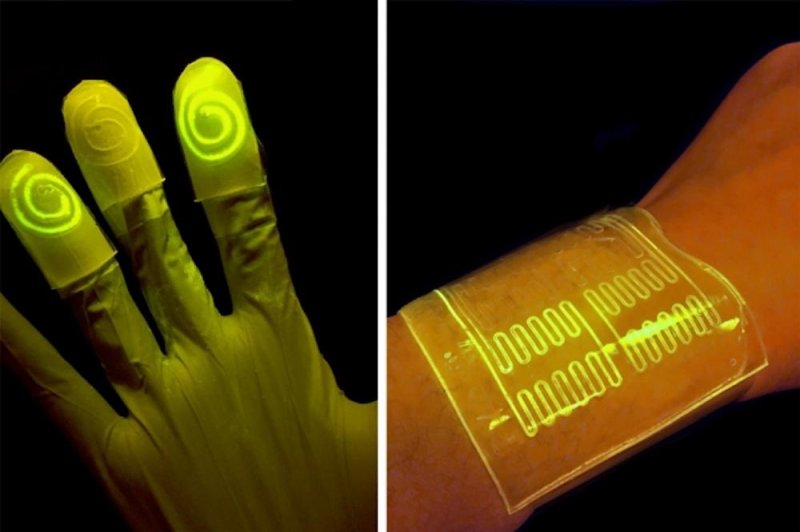Researchers used a biocompatible hydrogel material to keep engineered bacteria cells alive and active inside wearable sensors. Photo by MIT
Feb. 16 (UPI) -- Scientists at MIT have crafted wearable sensors out of cell-infused hydrogel film. Researchers used the new "living material" to design gloves and bandages that light up when they come in contact with target chemicals.
The hydrogel's watery environment provides nutrients to injected cells, keeping them alive and functioning as designed.
"With this design, people can put different types of bacteria in these devices to indicate toxins in the environment, or disease on the skin," Timothy Lu, an associate professor of biological engineering, told MIT News. "We're demonstrating the potential for living materials and devices."
Previous scientific breakthroughs have allowed researchers to engineer cells to perform a variety of functions, like lighting up when they come in contact with specific chemical compounds.
For Lu and his colleagues, the challenge was to keep programmed cells alive outside of a Petri dish.
The new biocompatible hydrogel developed by the team of engineers, a combination of a polymer and water, improves on previous attempts to bring engineered cells outside of the lab.
Researchers carved tiny channels through the hydrogel layers using 3D printing and micromolding methods. They then affixed the hydrogel film to a porous layer of rubber, which offered protection without sacrificing access to oxygen. Finally, the engineers injected programmed E. coli cells into the channels before soaking the entire material in a solution of nutrients.
"The challenge to making living materials is how to maintain those living cells, to make them viable and functional in the device," Lu said. "They require humidity, nutrients, and some require oxygen. The second challenge is how to prevent them from escaping from the material."
Their final material kept the cells alive and active for several days, even as they stretched and folded the material.
In a series of tests, researchers injected different engineered cells into separate channels in a hydrogel-elastomer bandage. Each channel glowed green in response to contact with a different chemical compound.
Researchers repeated the experiment using a hydrogel-elastomer glove with engineered cells injected into the tiny channels carved into the glove's fingertips. The tips glowed green when the glove wearer picked up cotton balls soaked with the target chemicals.
Scientists described their living material breakthrough in the journal PNAS.















